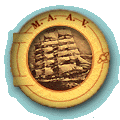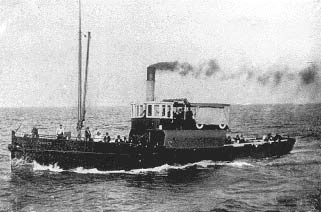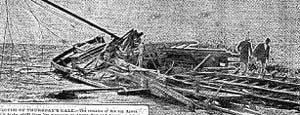|
|

|
||||||
|

|
Photo courtesy Bob Leek |
![]() he wooden steamer Agnes (O.N. 101772) was built in 1894 at Launceston for use in the Tamar River trade for Robert Gardner of Launceston. The Agnes was built as a screw steamer of 44 tons gross (16 tons net) she had a length of 92 feet, width 14 feet and depth 5 feet. Wrecked behind the Williamstown Rifle Range in 1933 the Agnes was discovered in 1971 by a founding member of the MAAV, David Carroll. The MAAV produced a brief report on this vessel that same year. Located in an easily accessible area known as the Jawbone the Agnes wrecksite makes for an interesting dive.
he wooden steamer Agnes (O.N. 101772) was built in 1894 at Launceston for use in the Tamar River trade for Robert Gardner of Launceston. The Agnes was built as a screw steamer of 44 tons gross (16 tons net) she had a length of 92 feet, width 14 feet and depth 5 feet. Wrecked behind the Williamstown Rifle Range in 1933 the Agnes was discovered in 1971 by a founding member of the MAAV, David Carroll. The MAAV produced a brief report on this vessel that same year. Located in an easily accessible area known as the Jawbone the Agnes wrecksite makes for an interesting dive.
In August 1909 the Agnes arrived in Melbourne from Launceston to commence a ferry service between Williamstown and Port Melbourne, the Bay Ferry Company having chartered her for this purpose.
She was described as having an espacious cabin for the ladies, and a covered in top deck with outside accommodation on the main deck.
Her sea-going qualities were well regarded; she made 10 knots on the her Bass Strait crossing without shipping a drop of water in spite of running into a strong northerly wind when off Goose Island.
Not long after her arrival she commenced her service, and in October that year the Melbourne Ferries Company was granted a license from the Melbourne Harbor Trust.

|
Photo courtesy Bob Leek |
The Agnes commenced her 7.00 AM morning run from Port Melbourne to Williamstown when she lost her way. She groped her way around Hobson's Bay on the three-kilometre trip almost running into a steamer anchored in the Port Melbourne bight. Once clear of the steamer she nearly ran onto the rocks that formed the river training wall at the mouth of the Yarra. Her last misadventure for the day was finding herself at the Ann Street Pier that was situated 400 metres east of her destination, Gem Pier, she carefully crept her way through the fog to Gem Pier.
In May 1910, the Agnes was returned to her owners in Tasmania, the new ferry Williamstown took her place. The previous ferries employed in the same service, the Queen, Baldrock and the Motorgem were described as being a disappointment.
The Agnes spent the next ten years plying in the waters of Tasmania until purchased in 1920 by Captain McBain of Williamstown with a party of locals.
The consortium planned to use her on the run between Melbourne and Williamstown, operating in the beer trade which Cowper and Son had previously used their vessel the S.S. Oscar.
The Agnes operated as a tug for McBain and Morwick until November 1931 when she was sold; there were several changes of ownership until being bought by J.L. Dyson, of W.H. Dyson and Sons, who were cartage contractors from South Melbourne.
They removed her steam engine and replaced it with an oil engine and converted her into a ketch that was intended to be used in the shell grit trade.
The Agnes had been moored at various berths around the Port of Melbourne until removed from the Harbor Trust's territory in early December 1933.
Her working life as a ketch was short-lived, for on the 14th of December 1933 she was blown from her mooring in a strong south-westerly wind to be wrecked at the back of the old Williamstown Rifle Range.

|
Photo courtesy Bob Leek |
Two reports from the Melbourne Harbour Trust explain the circumstances of the wrecking which make interesting reading:
Harbour Masters Report. No 43/33. Date 18/12/1933. Subject: Wrecking of the former tug Agnes at back beach, Williamstown on 14/1.2/33.
Sir,
I beg to report that the former tug Agnes went ashore at the back beach, Williamstown during the heavy weather on night of 14th inst.
A.H.M. Capt. Startup was called out and having hired a car at a cost of 6/ -d. proceeded to the scene but could do nothing. He found the vessel hard on a reef at the back of the Rifle Butts and being rapidly broken up by the heavy seas. It was thought that three men were on board the vessel but no sign of these men could be seen and it was later ascertained that the men had left the vessel earlier in the day. The Agnes 44 tons gross was originally owned by Mc Bain and Morwick and since being sold in November, 1931 has had several owners the last being J.L. Dyson of W.H. Dyson & Sons, Cartage Contractors of South Melbourne, who took the steam engine out and substituted an oil engine and intended to use her in the shell grit trade. The vessel was moored at various berths in the port until 2/12/33 when she was removed from the Trust's territory.
Yours faithfully Capt. Kerr Harbour Master.
The following letter is a memo from Capt Startup to Capt. Kerr. 15/12/1933.
Sir,
I beg to report that at 4.50 pm on the 14th (14/12/1933) I was notified by the Williamstown Police that the Ketch Agnes was ashore at the back beach. After notifying you I attained a car and went around to inspect the position and see if anything could be done. It was thought that there was a crew of three men on the ketch and she was in a position of great danger. I went around to the wreck, I got as close as possible from the land side. I found her hard up on the reef at the back of the Rifle Butts not far from the middle beacon mark at the entrance to Koroit Creek. No sign of a crew were visible and the vessel was in a position unapproachable from seaward. She had been at anchor off this spot for a few days. The vessel is entirely unequiped with the necessary gear to operate in the shell grit trade and like the rest of Dyson's craft are manned by inexperienced crews and not fitted out with the necessary gear to carry on their business, I consider them a danger to themselves and other vessels using the port.
Yours faithfully Capt Startup.
11922.23 Register of Australian and New Zealand Shipping
Comments such as these pose more questions than answers, such as what was the Agnes doing anchored off the Rifle Range for so long?
References:
Bob Leek Archives
11922.23 Register of Australian and New Zealand Shipping
|
|
What's there now?
The wreck is scattered over a large area with various iron knees, some bronze fastenings and about 40 feet of hull, a winch that is slowly being covered with sand and sea grass. Research into this Australian built vessel is ongoing.